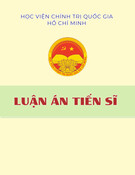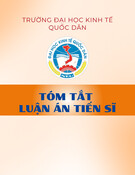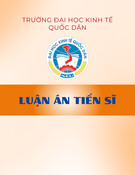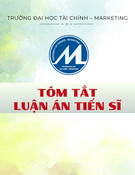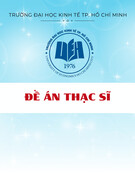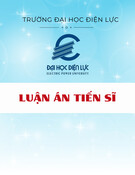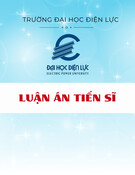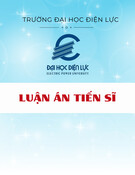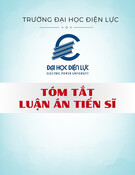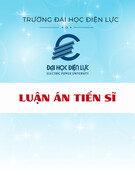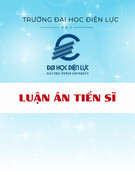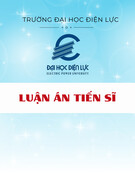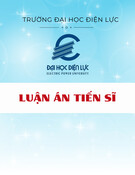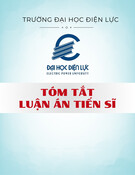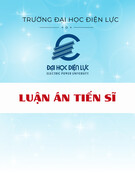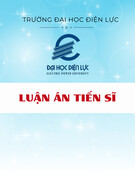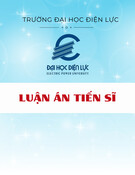2
INTRODUCTION foreign ownership has a positive effect on firm performance, and there is a non-linear relationship between state ownership (inverted 1. Rationale U-shape) and foreign ownership (U shape) with firm performance Although research on the relationship between ownership (Phung Duc Nam and Hoang Thi Phuong Thao, 2013; Le Duc structure and firm performance is no longer a new topic, it is always Hoang, 2015); state ownership has a negative impact on firm an attractive scientific topic because of the diversity of research performance in general, but has a positive effect on large-scale firms approaches, research results explained by the theoretical basis, (Ngo My Tran et al., 2014). However, each research result has research methods, different research conditions ... In particular, the certain research limitations or gaps: study of ownership structure related to the performance of state- - Studies on the relationship between ownership structure and invested enterprises which is an indispensable part of the economy of firm performance often focus on the impact of ownership structure most countries in the world (OECD, 2019) has increasingly attracted on firm performance; however, the impact of firm performance on more attention from not only scientists, business managers but also ownership structure remains a research question for the Vietnamese government agencies. firms case. International studies on the impact of ownership structure (with - The transformation of ownership forms associated with the many forms of ownership: state ownership, private ownership, market mechanism also goes hand in hand with the transfer of social domestic ownership, foreign ownership ...) have shown many results functions, the policy burden from state economic sectors to other of the relationship between ownership structure and firm economic sectors and then there is no difference between the goals of performance. The reason for the differences of the research results of state ownership and other ownership components. Approaching from the impact of ownership structure on firm performance is the this point of view, ownership structure may not be a decisive factor distinctions of characteristics in each country as well as socio- in firm performance but rather market competitiveness (Vickers, economic characteristics over many periods of each country. 1995; Martin and Parker, 1997; Lin et al. the, 1998). On the other In Vietnam, researches on factors (including ownership factors) hand, when state-invested enterprises join the stock market, firm affecting the performance of state-owned enterprises present some performance through market signals can affect the ownership test results which indicate that a relationship exists between the structure. However, previous studies in Vietnam have not impact of ownership structure and business performance: A low approached and explained the relationship between ownership proportion of state equity (less than 50%) has a positive impact on structure and firm performance on the basis of some theories firm performance after equitization (Tran Thi Thanh Tu and Pham associated with market and competition factors such as theory of Viet Hung, 2013); state ownership has a negative effect while competition and signalling hypothesis.
3
4
For the above reasons, the study of the topic "Ownership + Effects of some related factors (such as size of enterprise, structure and performance of state-invested enterprises in Vietnam" financial leverage, ...) in two-way relationship between ownership can help explain the relationship between ownership structure and structure and firm performance. firm performance in the case of Vietnamese businesses. This - Some recommendations on the implications of restructuring contributes to enriching the wealth of knowledge related to this topic. policy to improve firm performance with state capital investment In practice, given the important position and role of the state economic sector in the economy, the process of restructuring and innovation to improve the performance of SOEs in Vietnam has been from research results. • Object of the study: Relationship between ownership structure and the performance of state-invested enterprises in Vietnam. carried out for over 25 years, which results in certain achievements. • Scope of the study: Two of the many policy solutions that have been promoted by the - Enterprises with state capital investment in Vietnam, except: Vietnamese government in recent years associated with ownership enterprises with 100% state capital investment, enterprises operating restructuring are the equitization of SOEs and the divestment of state in the fields of finance, banking and insurance; investment in enterprises. However, the process of equitization and - Sample of 429 state-invested enterprises listed on the Vietnamese divestment has not achieved the planned goals, there are still many stock market (HNX, HOSE), with data collected over an eight-year problems and limitations. Therefore, the selection of the above period (2010 - 2017). 3. Research method research topics will also contribute to providing more scientific basis and policy implications on practical problems posed for more The thesis mainly uses quantitative research method: Verification of the relationship between the ownership structure and performance of state-invested enterprises in Vietnam. effective policy implementation in the coming time. 2. Objectives, scope and object of the study • Objectives of the study: In addition to the main research method above, the thesis uses - The interaction relationship between the ownership structure other methods such as analysis and synthesis methods to systematize and performance of state-invested enterprises in Vietnam, especially theoretical problems, literature overview; statistical and comparative state ownership. methods to clarify the current situation of the ownership structure + The impact of ownership structure on firm performance; and performance of state-invested enterprises in Vietnam. + The impact of firm performance on the state ownership component in the enterprise ownership structure;
5
6
Chapter 1 value. However, this perception is not entirely the same for investors; THEORETICAL BASIS OF OWNERSHIP STRUCTURE AND FIRM depending on the perception point of view, the appearance of the PERFORMANCE state as a major shareholder will generate either a negative or
1.1 Ownership structure positive signal to investors. 1.3.2 Competition theory According to the theory of competition, firm performance is Ownership structure of the enterprise is understood as the mainly determined by competition in the market rather than ownership; relationship between the equity components of the enterprise, the performance of SOEs and private enterprises will not have a determined by the correlation of the equity ratio held by the owners, significant difference in suitable competitive environment conditions. representing the relationship of ownership in the enterprise. In fair competitive market conditions, information reflecting Ownership structure is often studied in two aspects: by concentration business operating conditions can be obtained from competition, thereby overcoming the problem of asymmetric information; enterprises’ success is not related to the form of enterprise ownership, but full and fair competition is the premise for firm performance. and by shareholder characteristics: 1.1.1 Ownership structure according to concentration 1.1.2 Ownership structure according to shareholder characteristics 1.2 Firm performance 1.2.1 Viewpoints on firm performance The low efficiency of SOEs comes from soft budget constraints, which are financial support from the state due to policy burdens; Firm performance is a very wide category. It can be approached therefore, when the policy burden is removed, it is not necessary to from many aspects depending on the research objectives. According privatize SOEs if SOEs have the same performance as private firms to the majority of researches related to the topic of the thesis, the thesis focuses on the research of firm performance in terms of in a fair competition market. 1.3.3 Theory of endogenous ownership structure economic efficiency, with the research subject with each specific Ownership structure of a business should be considered as an endogenous result, reflecting the influence of shareholders and enterprise is the business operating efficiency. 1.2.2 The system of evaluation criteria for firm performance 1.3 The theory of the relationship between ownership structure transactions in the stock market. When the owner of a private enterprise decides to sell shares or when the shareholders of a joint stock company and firm performance 1.3.1 Signalling hypothesis decide to issue additional shares, these decisions will change the According to this point of view, the presence of state ownership structure of the enterprise and with probability ownership shareholding along with its level of ownership in an enterprise is structure will be more dispersed. Stock trading would then reflect the believed to have an impact on investors' perception of the enterprise's desire of potential and current owners to change their ownership stake in
7
8
the enterprise. The ownership structure that appears, whether centralized and at the same time, significantly reduced the debt level and increased or dispersed, must be affected by the purpose of maximizing the dividend rate. Such results can be found in researches by Boubakri shareholder returns, so there will be no systematic relationship between and Cosset (1998), Megginson and Netter (2001). Or the studies from the ownership structure and firm performance. the performance comparative approach of enterprises with the types of ownership: state, private, and mixed-owned, show the general results Chapter 2 of low-to-high firm performance of state-owned, mixed-owned and LITERATURE REVIEW private-owned enterprises (Ehrlich et al., 1994; Majumdar, 1998; Boardman et al., 2002). However, not all researchers agree with the above research results, for example, Aussenegg and Jelic (2002), Alipour (2013). The reason for the difference of research results is due 2.1 The impact of ownership structure on firm performance 2.1.1 Research by concentration 2.1.2 Research by shareholder characteristics to the difference in the characteristics of the countries as well as the * The impact of state ownership, private ownership on firm level of economic development between periods. performance With the research aspect of the concentration of ownership, research results of the relationship between ownership structure and firm performance are also very different. In China, in the relationship * The impact of foreign ownership on firm performance 2.2 Interaction between ownership structure and firm performance When researching into the relationship between ownership with firm performance, state ownership has a negative impact (Sun structure and firm performance, in addition to the main research and Tong, 2003; Wei et al., 2005; Lin et al., 2009); positive impact direction on the impact of ownership structure on firm performance, (Jiang et al., 2008; Ng et al., 2009); a U-shaped relationship (Wei et some researchers have simultaneously researched on the impact of al., 2005; Tian and Estrin, 2008; Lin et al., 2009; Yu, 2013), or an firm performance on the ownership structure: Loderer and Martin inverted U-shape (Sun et al., 2002; Wei et al., 2003). (1997), Cho (1998), Wei et al (2005), Hu and Izumida (2008a), In Vietnam, scientists also carry out researches from comparative Gurbuz and Aybars (2010) and Demsetz (1983), initiators of the approach such as Tran Tien Cuong et al (2006), Loc et al (2006), researches on ownership structure according to concentration and school “ownership structure is endogenous”. 2.3 Research gaps detection of relationship between ownership structure and firm With the view of the performance comparative approach of performance such as Phung Duc Nam and Hoang Thi Phuong Thao enterprises before and after equitization, most research results have (2013), Tran Thi Thanh Tu and Pham Viet Hung (2013), and Le Duc shown that the enterprises after equitization have substantially Hoang (2015). Regarding the method of selecting the research model, increased sales, increased profits, and improved executive efficiency, the above studies select the panel data model with the static table data
9
10
regression model through 3 methods of running the model: Pool-OLS, Besides, due to endogenous issues, through the impact of a random effect and fixed effect and testing to choose the right model. competitive market, firm performance will be able to affect the Most research results in Vietnam show that state ownership has ownership structure. This is also an issue that needs to be studied. a negative impact on firm performance, some studies show that state Chapter 3 ownership also has a positive impact when the level of ownership is OWNERSHIP STRUCTURE AND PERFORMANCE OF STATE - not concentrated (Tran Thi Thanh Tu and Pham Viet Hung, 2013); INVESTED ENTERPRISES IN VIETNAM an inverted U shape (Phung Duc Nam and Hoang Thi Phuong Thao, 2013; Le Duc Hoang, 2015). However, Vietnamese scholars have not conducted in-depth studies of endogenous ownership structures, the test models normally focus on the single effects of ownership components, or the models only study the unidirectional equations. Unlike the above studies, on the basis of the system of theories of signal hypothesis and competition theory, the research model in this thesis will be set up on the basis of viewpoint mainly from listed 3.1 State- invested enterprises in Vietnam 3.1.1 Classification of enterprises according to ownership criteria 3.1.2 State-invested enterprises 3.1.3 The role of state-invested enterprises 3.1.4 The measures and forms of arrangement and renewal of state - invested enterprises 3.2 Ownership structure and performance of state - invested companies on the stock market, there is no difference between the enterprises in Vietnam goals of state shareholders and other shareholders and therefore ownership structure by ownership characteristics will not have much influence on firm performance, the impact if any is mainly due to the issue of concentration or dispersion of the ownership structure (and 3.2.1 Ownership structure state-invested enterprises in Vietnam through the reform and renovation process 3.2.2 Performance of state-invested enterprises 3.3 Requirements the process of restructuring and for so the ownership components at the concentration level can all have improving the performance of SOEs when Vietnam joins a a positive impact on firm performance), due to the competition new generation of free trade agreement problem of the market. The above argument is also based on the In a nutshell, over 25 years of reorganization and renovation, the characteristic that state-owned enterprises listed on the stock market state-invested enterprise sector despite its gradual narrowing in are equitized SOEs, and the improvement of firm performance after number and fields of operation, especially a sharp decline in state- equitization is proven (according to the results of previous owned enterprises with 100% of charter capital or controlling shares; comparison school researches after equitization), and especially with However, it always plays a leading role in the economy, with the the positive impact on the performance of the listing (Tran Thi highest contribution to GDP compared to non-state enterprises and Thanh Tu and Pham Viet Hung, 2013).
11
12
Chapter 4 FDI enterprises. Through arrangement, renovation, the performance RESEARCH METHODS of the SOE sector has been improved. Among the measures and forms of arrangement and renewal of state-invested enterprises in 4.1 Research model and hypothesis recent years (such as: equitization, assignment, sale, transfer, merger, consolidation, dissolution of enterprises, restructuring capital Research model focuses on: (i) Testing the simultaneous effects sources, assets), measures that change the equity structure such as of ownership components on firm performance; (ii) Using two equitization, restructuring of capital sources, assets are measures that equations test to examine the interaction between ownership have a positive impact on the performance of the enterprises in consideration of general statistical data, especially equitization. However, the results of implementing these measures have been structure and firm performance. 4.1.1 Research hypotheses 4.1.2 Research model Equation 1: Examining the impact of ownership structure on firm limited recently, the equitization of SOEs has not made a performance fundamental change in the equity structure; the equitization and divestment progress is slow. Besides, there are no specific criteria - Linear impact test associated with the performance of SOEs when implementing equitization and divestment, but mainly based on sectors and industries. In fact, through statistical data, it shows that the performance of the SOE sector is still based on the scale and loan, - Test non-linear effects of ownership components on firm but the efficiency of capital use is low; the indicators of profitability performance with the addition of variables: performance compared between the period 2016-2018 and the period 2011-2015 decreased (while the other business sectors increased); the investment efficiency of the SOE sector has not met the requirements of reforming growth models through improving labor Inside: productivity, technology and governance capacity. Therefore, in the - The dependent variable: PF measures firm performance by ROA, coming time, continue to implement the policy of restructuring and ROE, TobinsQ. improve the performance of SOEs, the requirements of the new - The independent variables: State, InLocal, OrLocal, Foreign are generation FTAs for SOEs to operate under market mechanism, the % ownership of major shareholders (> = 5%), the State, domestic equal competition with other economic sectors, and transparency of individuals, domestic organizations (except the State) and the information in operations will be the issues to be addressed.
13
14
4.3 Research Data foreign. SquareY (in turn, the square of each element possessing the non-linear impact test) Research data includes all state-invested enterprises (as major - The control variables: X: includes variables: Firm size (Size); shareholders with a stake of 5% or more) listed on the stock market of financial leverage (LTD, STD); cost of debt (CostD); fixed assets Vietnam (HNX and HOSE) during the 8-year period from 2010 to 2017 (FixAss); liquidity (Liq); age of firm (Age). provided by Vietstock, excluding enterprises in the financial sector due - The dummy variables: Year is the dummy variable of time, to the specific business characteristics of this sector (Rajan and Zingales, Industry is the industry dummy variable. Board: Firm that the State 1995). With the sample of 429 enterprises in 8 years, the number of holds controlling or not controlling shares, value 1 if State> = 50% corresponding observations is 3.432, of which 2.495 are state-invested. and value 0 if State <50%.
4.3.1 Sample descriptive statistics 4.3.2 Correlation relationship between variables Equation 2: Examining the impact of firm performance on ownership structure (state ownership), using the following estimation model: The results of the Pearson correlation test at 5% correlation significance to test the linear relationship between the independent variables and the dependent variable showed that the existence of a correlation between state ownership and firm performance allows the implementation of regression models to analyze the impact of state - The dependent variable: Dstate: equal to the annual state equity ownership on firm performance. In addition, the existence of correlation ratio (t-1) - annual state equity ratio (t) / annual state equity ratio (t-1)). relationships between independent variables, potential multicollinearity - The independent variables: PF (according to indicators ROA, problem should be noted when analyzing regression, especially the ROE, Tobin-Q). correlation between the group of variables on the ownership structure - The control variables: Including some variables with measures (State, InLocal, OrLocal, Foreign) with debt structure (LTD, STD, Lev). such as Model 1: LTD, Size, FixAss; dummy variables Year, Industry, Board; and additional variables Rgrow (Annual revenue Chapter 5 growth), OwnEq (% equity to equity ratio). 4.2 Methods of data analysis RESEARCH RESULTS AND DISCUSSION In addition to using the static table data regression model method as the majority of previous studies, expanding the research according to dynamic table data regression model for analysis. 5.1 The impact of ownership structure on firm performance 5.1.1 Test of linear relationship 5.1.2 Test of non-linear relationship
15
16
enterprises has no statistically significant linear impact on firm performance; especially in contrast to some previous research results (inverted U-shape), the results of the non-linear (U-shaped) impact of 5.2 The impact of firm performance on ownership structure 5.3 Some extensive studies 5.3.1 Research with the dynamic regression model through GMM There is no case of conflicting results between the static model state ownership on firm performance can show that SOEs after equitization, once the conditions for listing on the stock market have been ensured, corresponding to the conditions of scale, finance, and the dynamic model. 5.3.2 Research on the impact of state ownership on firm performance in a number of industries and fields transparency in operations ..., with inherent objective advantages of The results of testing research data for the construction industry the state ownership, state ownership at a certain concentration will be (proportion of 26.3% of the total number of enterprises) and the proportional to firm performance (The research results are explained manufacturing industry (proportion of 31% of the total number of on the basis of competition theory, theory of signalling hypothesis). enterprises) show that: The factors of industries and fields of Comparing with the research results on firm performance of operation of enterprises have certain influence on the relationship SOEs in the period before and after equitization, the results of the between the ownership structure and the performance of the state- non-linear inspection according to the above explanation are also invested enterprises. consistent with the reality as well as previous inspection studies, Main testing results in Part 5.1 and 5.2 are summarised in Table which showed that activities of SOEs after equitization are more 5.1 and 5.2; the conclusion is as follows: effective than before equitization. - First, the results in Table 5.1 confirm the positive role of the In addition, expanding research on the impact of state ownership domestic private sector for SOEs after equitization when there is a on firm performance in some fields (construction, production) shows positive linear relationship with the SOE (similar to many previous that the industry, the field of operation of the enterprise has certain studies ); the appearance of foreign ownership has a negative impact influence on relationship above. Therefore, the proposed policy on firm performance when there is a negative linear relationship implications on the basis of test results will need to take into account (unlike many previous research results, which is a positive impact, this factor. this is explained by the dispersion of foreign ownership due to legal - Third, with the results in Table 5.2, the performance of SOEs regulations in Vietnam), but it will play an active role if a certain listed on the stock market has a positive impact on the level of state degree of concentration exists when a non-linear relationship also divestment, proving the attractiveness of SOEs which operate exists (U-shaped). effectively for private investors. On the other hand, the results show that - Second, Table 5.1 shows that state ownership as well as the current divestment policy of state capital investment in SOEs after whether the state holds the right to dominate or not to dominate equitization needs to take into account the firm performance factor.
17
18
Table 5.1 Impacts of ownership structure on firm perfomance - Fourth, Table 5.1 shows that ineffective use of loans, depending on the size of enterprises with state capital investment ROA ROE No Variables (similar to most previous research results); meanwhile, regarding the size of enterprises, the results in Table 5.2 also partly reflect the policy of increasing the divestment of state capital investment in large-scale enterprises (corporations, groups) in the research period when the size of enterprises has the same impact direction as state divestment. - Fifth, the issue of representatives, land assets, the level of equitization are bottlenecks in the restructuring of state-owned enterprises, which can be seen from Table 5.2, this test result is completely consistent with the current situation of Vietnam in the restructuring process. In addition to the conclusions drawn from the static model test results mentioned above, when expanding the study to test the I Group of independent variables A Linear impact State ownership 1 2 InLocal ownership 3 OrLocal ownership 4 Foreign ownership B Nonlinear impact State ownership 1 2 InLocal ownership 3 OrLocal ownership Foreign ownership 4 The state dominates (equity> = 50%) 5 II Group of control variables + + - U Tobin Q + U + - dynamic model of the impact of ownership structure on firm performance, there are no signs of the effects of the components LTD (long-term liabilities / total assets) STD (short-term assets/short-term liabilities) like static model. With this result, the change of equity structure does not affect firm performance. This is appropriate when the stock market develops, the change of equity structure becomes frequent due to trading and investment activities in the market, especially in the short term. In a competitive environment where 1 2 3 CostD (financial expenses / liabilities) Liq (short-term assets/ short-term liabilities) 4 Size (logarithm of total assets) 5 6 FixAss (fixed assets / total assets 7 Age (age to list on the stock market) 8 Board (dominant state > = 50%) - - - + - - - - + - - - + - - there is no difference between the goals of state shareholders and other shareholders, the change in ownership structure will not affect firm performance. This conclusion should be noted when implementing the policy of divestment of state capital investment in SOEs after equitization, listed on the stock market, operating effectively. Notes: (i) Same direction impact (+), opposite direction impact (-); (ii) The results aggregated on the above table is the static model test result; (iii) The dynamic model test results have no cases of conflict with the static model results, the main difference is that the ownership components have no impact on firm performance.
19
20
Table 5.2 Impacts of firm performance on state ownership structure Chapter 6 RECOMMENDATIONS ON POLICY IMPLICATIONS No Variables Dstate (state divestment) ROA 1 ROE + 2 TobinsQ + 3 6.1 Some recommendations on the implications of restructuring and improving performance of state-invested enterprises 6.1.1 State divestment policy in post-equitization enterprises should take into account the firm performance factor, especially when the LTD (long-term liabilities / total assets) 4 enterprises are listed on the stock market, operating effectively Board (dominant state> = 50%) - 5 For SOEs after equitization, when they have met the conditions Size (logarithm of total assets) + 6 to be listed on the stock market, corresponding to the conditions of FixAss (fixed assets / total assets) - 7 scale, finance, transparency in operations ..., with inherent objective OwnEq (% equity / equity) + 8 advantages of state ownership, state ownership at a certain level of RGrow (annual revenue growth) + 9 concentration, will have a positive impact on firm performance. Note: Same direction impact (+), opposite direction impact (-) Therefore, when an SOE has been equitized, although the level of equitization has not been achieved compared to the approved plan, operates effectively, especially it is listed on the stock market, the continued divestment of state investment in order to achieve the target for the percentage of shares held by the State under the
approved plan needs to be considered. 6.1.2 Equity policy attracts foreign investors, takes advantage of and promotes the active role of foreign ownership Loosening the ownership ceiling of foreign investors when the State offers securities to the public, focusing on selection of foreign
strategic investors in SOE equitization. 6.1.3 The investment of state capital in enterprises should come from the main economic efficiency; determine competition is the main driving force to improve firm performance.
21
22
CONCLUSION Activities of enterprises with state capital investment compliance with market mechanism, equal competition with in enterprises of other economic sectors in accordance with the law; publicity and For Vietnam, developing a socialist-oriented market economy transparency of enterprises' operations and accountability in corporate with many forms of ownership, many economic sectors in which the governance (especially SOE holding dominant shares) are important state economy with state- invested enterprises as a part, playing the main role is the constitutional view of development. In the process of restructuring to improve the performance of state-invested enterprises, factors in promoting firm performance. 6.1.4 Exactly identify bottlenecks in restructuring enterprises with state-invested enterprises; focus on representatives, land in addition to improving capital management capacity in SOEs, the reorganization of SOEs, restructuring of state-invested capital in order to diversify forms of ownership, changes in corporate governance have been promoted by the State. assets, and equitization level. 6.2 Recommendations for implementation of policy implications 6.2.1 Recommendations to the Government, the Prime Minister - Improve mechanisms and policies for SOEs to operate under In that context, the thesis sets out a general research goal of the the market mechanism; two-way relationship between the ownership structure and - Review and narrow down the fields and industries that the performance of state-invested enterprises in Vietnam, with the focus State must invest in, classify the level of ownership according to a on state ownership in equity structure; thereby proposing solutions to reasonable group, heading towards the market’s deciding on the improve performance of state-invested enterprises, and broadly the ownership structure but still ensuring the State's control; efficiency of management and investment of state capital in - Focus on removing bottlenecks of the equitization and enterprises. Approaching research on the basis of a number of theories such as competition theory, signal hypothesis theory, the theory of divestment process. 6.2.2 Recommendations to the Ministry of Finance, the Committee for the management of state capital invested in enterprises, and endogenous ownership structure; through the data verification results units assigned to manage state capital invested in enterprises of state-invested enterprises listed on Vietnam's stock market, the - Continue to improve the model and improve the management capacity thesis has confirmed the active role of domestic private ownership of State capital invested in enterprises to meet practical requirements; for SOEs after equitization when there is positive linear relationship - Strengthen the openness, transparency and accountability of with firm performance; the presence of foreign ownership, if firm performance; dispersed, has a negative impact on firm performance when there is a - Renovate, enhance corporate governance quality, improve firm negative linear relationship, but it will play a positive role if it performance. reaches a certain level of concentration when it also exists non-linear
23
24
relationship (U-shaped). Meanwhile, in contrast to many previous down the fields and industries that the state must invest and research results, the results of the non-linear (U-shaped) impact of implement diverse ownership forms, heading towards the market’s state ownership on firm performance can show that for SOEs after deciding on the ownership structure, (iii) removing bottlenecks of the equitization, when they are to ensure the conditions to be listed on equitization and divestment process, (iv) continuing to improve the the stock market, corresponding to the conditions of scale, finance, model and improve the management capacity of state capital transparency in operations ..., with the inherent objective advantages invested in enterprises, (v) enhancing the openness, transparency and of the state-owned components, state ownership at a certain level of accountability of the enterprise's performance, (vi) innovating and concentration will be proportional to firm performance. enhancing the quality of corporate governance through strengthening On the other hand, firm performance has a corresponding internal supervision and promoting the role of the Board of impact with the level of state divestment, demonstrating the results Directors. of the accelerated divestment of state investment over the past time In terms of methodology, compared with previous studies with as well as the attractiveness of state- invested enterprises operate the same topic, the thesis also studies the impact of firm performance effectively for private investors. In addition, the test results also on the change of ownership structure, and the endogenous problems show that ineffective use of loans, heavily dependent on the size of of ownership structure, with the scope of research is all state-owned enterprises with state capital investment; the issue of representatives, enterprises listed on Vietnam's stock market; in addition to testing land assets, the level of equitization are the bottlenecks in the the static table data regression model, the research expansion of the restructuring of enterprises with state capital. dynamic table data regression model contributes to further From the research results, the thesis has given a number of consolidating the reliability of the research results. policy implications such as (i) the policy of state divestment in post- Besides the results achieved, due to the limited information and equitization enterprises should be prudent, associated with firm data, the thesis has not tested the difference between listed and performance, (ii) equity policy attracts foreign investors, (iii) state unlisted companies; has not considered and studied in depth the capital investment policy is mainly based on economic efficiency, effects of factors such as the industry sector, economic competition is the main driving force to improve firm performance, characteristics in each period under the influence of inflation and (iv) major bottlenecks in the equitization and divestment of state interest rates. In addition, the research in the thesis is mainly based capital. At the same time, through the above policy implications, the on the static model, is initially approached in perspective of dynamic thesis also gives a number of related recommendations, focusing on model research. The above shortcomings and limitations may be the (i) perfecting mechanisms and policies for businesses to operate suggestion for further researches in the future./. according to the market mechanism, (ii) reviewing and narrowing



